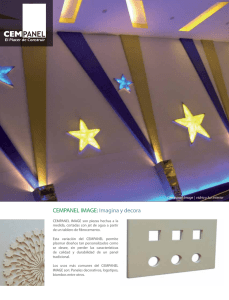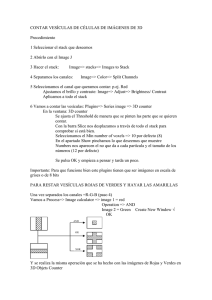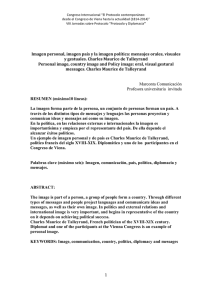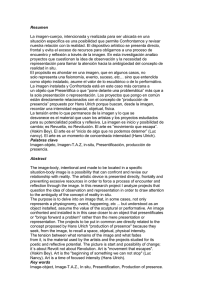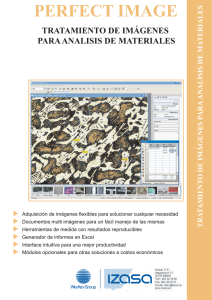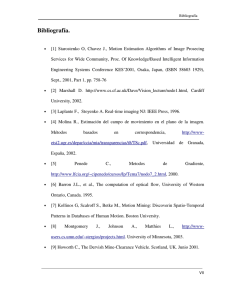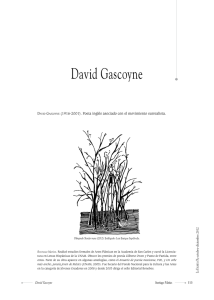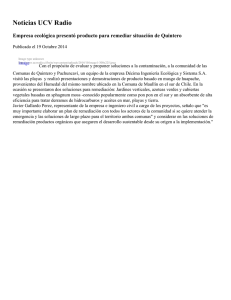del profesor Gabriel Cristobal (CSIC - ELAI-UPM
Anuncio
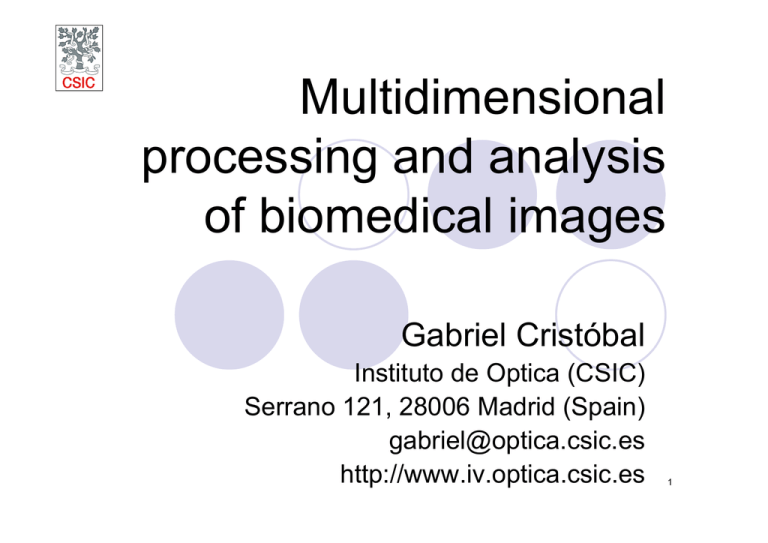
Multidimensional processing and analysis of biomedical images Gabriel Cristóbal Instituto de Optica (CSIC) Serrano 121, 28006 Madrid (Spain) [email protected] http://www.iv.optica.csic.es 1 Collaborators z Noemí Carranza, Instituto de Optica, CSIC, Madrid, Spain z Elena Gil, Instituto de Optica, CSIC, Madrid, Spain z Salvador Gabarda, Instituto de Optica, CSIC, Madrid, Spain z Peter Schelkens, Vrije Univ. Brussels z Heiko Neumann, Univ. Ulm, Germany z Boris Escalante, UNAM, Mexico z Filip Sroubek, Academy of Sciences Czech Rep, Prague z Rodrigo Nava, UNAM, Mexico z Mathias Keil, Centro Visión por Computador, Barcelona, Spain z Leon Cohen, Hunter College CUNY, USA z Doug Nelson, Dept. of Defense, USA z Patrick Loughlin, Univ. Pittsburgh, USA z Ted Maddess, Australian National University, Australia z Manuel Forero, Univ. Birmingham, UK 2 Outline z Motivation z Time-frequency analysis in signal processing. { Image fusion. Deconvolution { Overcomplete representations { Motion estimation { Image quality assessment z Superresolution zComplementary actions zConclusions. Further research 3 Outline z Motivation z Time-frequency analysis in signal processing. { Image fusion. Deconvolution { Quality estimation { Motion estimation z Superresolution zComplementary actions zConclusions. Further research 4 Time-frequency representation moto z Time-frequency representations can be considered as the“Holy Grail” i.e. they constitute a keystone in the area of signal Processing/Analysis (Jelena Kovacevik, Univ. Maryland) z Understanding the significance of the blob-like structure of time-frequency representations Musical score analogy 5 Which are the foundations? z WD is the most prominent quadratic TF representation zOriginally it was defined by Wigner in 1932 in Quantum Mechanics zLater (1948) Ville derived the same WD in signal analysis zIntroduced in Optics by Bastiaans in 1978 6 TF-based multidimensional SP z TF representations can be extended beyond 1D, scalar or deterministic signals 1D complexity 2D 3D 3D+t ND? • 3D texture • CMR analysis • Phonocardiograms • Texture • Optical flow • High-order texture • ECG estimation • Image fusion • Epileptic seizures • Earthquake precursor • Image deconvolution • Image analysis waves (crack detection) • Speech • Optics • Audio/acoustics • Machine diagnosis/ • Radar imaging •… fault detection • Source localization • Quantum Mechanics •… • Mathematics 7 Wavelets vs joint representations 8 WD computation of 2D signals 9 Hybrid optical-digital system Displacement unit Object Fourier WD lens mirror Fourier lens 10 Texture segmentation using PWD+PCA 15x15 31x31 11 Patt. Rec. Letters, 20, pp. 481-487,1999 Recent 2D Applications zMultitemporal image fusion 12 Multitemporal image fusion 13 Recent 2D Applications zBlind deconvolution 14 Recent 2D Applications z Multifocus image fusion 15 1D Applications Detection of events in biological signals z control arrythmia 5th Int. Workshop on Information Optics, AIP Proc. Vol XX, 2006 16 1D Applications z(n) Biomedical signal Steps n 1) Discretize signal 2) Calculate a Time-frequency representation (TFR) of the signal 3) Measure Rényi entropy Time-frequency representation W(n,k) W(n = ni , k) n Rényi entropy Entropy is measured in a instant-wise scheme. The PWD corresponding to instant n is considered to perform the entropy measure R(n) Rα = 1 ⎛ ⎞ log 2 ⎜ ∑∑ Pα (n, k ) ⎟ 1−α ⎝ n k ⎠ n 17 1D Applications- Results control Murmur (aortic stenosis) 5th Int. Workshop on Information Optics, AIP Proc. Vol XX, 2006 18 Image quality enhancement 1/2 19 Image fusion 20 Image quality enhancement 2/2 z In the case of heavily degraded hazy images, a new element can be added to the pixel-wise frequency distribution. This new element takes account of the gray-level information of the pixels and gives a different weight to each one. ⎛ z [ n] − B λ = μ ⎜1+ A ⎜ C ⎝ ⎞ ⎟ ⎟ ⎠ 21 5.Examples Multisensor images (1) a and b: Input images. c: Resulting fused image by applying a multiscale transform method. d: Resulting fused image by applying the Wigner-Rényi method. The areas within the white frame appear magnified in the figure below. 22 5.Examples Multisensor images (2) a and b: Input images. c: Resulting fused image by applying a multiscale transform method. d: Resulting fused image by applying the Wigner-Rényi method. The areas within the white frame appear magnified in the figure below. 23 5.Examples Multisensor images (2) 24 Image fusion-feature level Fused pixel-level contour-level 25 Outline z Motivation z Time-frequency analysis in signal processing. { Image fusion. Deconvolution { Quality estimation { Motion estimation z Variational methods {Superresolution zComplementary actions zConclusions. Further research 26 Image quality evaluation Una nueva herramienta para la evaluación de la calidad de imágenes R. Nava, A. Gallego and G. Cristóbal Congreso Asociación Española para la Ingeniería Biomédica (CASEIB), Pamplona, November 2006 (submitted) 27 Calidad de imagen Conceptos básicos Calidad de imagen 28 Todas las imágenes desenfocadas tienen MSE=200, pero su calidad es muy diferente! Absolute entropy measures. From blur to noise 29 An ideal quality metric? 30 Entropy histogram noise index (EHNI) ⎛ 1 ⎞ 1 EHNI = log ⎜⎜ ⎟⎟ 4 ⎝ H (J ) ⎠ Left column: A) Source image. B) Image plus 20% of Gaussian noise. C) Image plus 40% of Gaussian noise. D) Image plus 60% of Gaussian noise. Center column: Pixel-wise entropy Right column: Histograms of the entropy of the images. 31 Denoising results: retina fundus 32 Outline z Motivation z Time-frequency analysis in signal processing. { Image fusion. Deconvolution { Overcomplete representations { Motion estimation z Variational methods {Superresolution zComplementary actions zConclusions. Further research 33 e4 e3 e2 log-Gabor wavelets Dictionary construction e1 Simple cell model: Position, orientation, scale and phase selectivity, log-Gabor shape. Gabor: optimal space-frequency joint localization Similar to independant components of natural images [Olshausen97]. Multiscale - multiorientation (inspired from V1). Wavelets: convolution by a discrete set of filters which are rotated / scaled one another. Å--- orientations ---> Å---- Scales -----> Å---- Scales -----> 3.A. Phase 0° Phase 90° 34 3.B. Facilitation Inhibition Lateral inhibition Complex cells inhibition: Edge localization by non-maxima suppression [Heitger92]. 35 3.B. Facilitation Facilitation Method for contour saliency: - Thresholding on amplitude. - Chain length [Yen98]. - Parent coefficients across scales. complex cell chain length inhibition 36 3.B. Multiscale edge extraction: example Complex cells Lateral facilitation Lateral inhibition Fischer S., Perrinet L., Redondo R. and Cristóbal G.: “Sparse coding of images inspired by the functional architecture of the primary visual areas”, EURASIP JASP Image Perception, in press. 37 Motion analysis z Motion analysis is based on disparity information z Disparity1 is derived from sucesive frames in time z In contrast with stereo disparity, motion disparity defines complex-valued (vector field) 1Disparity is a measure of the relative displacement between ‘corresponding’ points of two images 38 Cardiac motion estimation CMR is recognized as the best imaging method for exploration cardiac function z Analysis of heart wall deformation { Estimates the location of ischemic myocardial injury { Determine myocardial effects of coronary artery diseases Example of evaluation of ischemic injury 39 Pre-processing stage Filtering + Thresholding 40 Schematic Block Diagram 41 With CMR Sequences z Ideal conditions are not met { Not guaranteed uniform velocity { Deformable cardiac wall First image Last image { Correlation variable with time { Plane not detectable Get uniform correlation with a probabilistic approach 42 Optical Flow (1 cycle diastole) 43 Outline z Motivation z Time-frequency analysis in signal processing. { Image fusion. Deconvolution { Overcomplete representations { Motion estimation z Superresolution zComplementary actions zConclusions. Further research 44 Qué es la superresolución? Límite aumento: X2-X2.5 45 Objetivos zGenerar una imagen de alta resolución a partir de diferentes imágenes de baja resolución de la misma escena z La imagen de alta resolución es aquella que proporciona mayores detalles (no simplemente más pixels) 46 Cómo se obtiene la SR? Deconv Registro de imágenes SR Matriz de alta resolución Imágenes de Baja resolución 47 Ejemplo de aplicación: identificación de matrículas 48 Otros métodos de SR Random Lens Imaging, Fergus, Torralba and Freeeman, MIT, TR 2006-058 ‘Image and depth from a conventional Camera with a coded aperture’, Levin, Fergus, Durand, Freeeman, SIGGRAPH’07 ‘Compressive sensing’ 49 Microscopía automatizada z Microscopio biológico MOTIC, modelo BA-400 Triocular, equipado con un sistema de objetivos de contraste de fases de 10X, 20X, 40X y 100X. El sistema de iluminación es Koehler con lámpara halógena de 6V 30W centrable. z Pletina motorizada en XYZ modelo H101 de Prior Scientific, siendo la motorización en Z independiente y adaptable a través del sistema de enfoque del microscopio. La resolución (paso) de la motorización en XY es de 0.1-5 micras dependiendo de la configuración del controlador. 50 Microscopía automatizada z Unidad controladora mediante puerto RS232 de los motores z Cámara Moticam refrigerada de alta resolución MC 3000-C de 3.3 Mpixels con refrigeración Peltier, conexión mediante IEEE 1394 o a través de tarjeta PCI con salida IEEE 1394. 51 Microscopía automatizada 52 Detección e identificación de micobacterias de tuberculosis (TB) Ejemplo de imagen que contiene micobacterias de TB • • Automatización en Microscopía: Microscopio MOTIC, Pletina Prior, Cámara Moticam, Fluorescencia ImageJ (http://rsb.info.nih.gov/ij/) 53 Esquema general del sistema de análisis de muestras Autoenfoque Z Escaneado X-Y Análisis+ ROC Captura Prot. autom. Umbralización de color adaptativa Extracción canal verde Validación Clínica Prot. análisis Validación color Detección bordes + operadores morfológicos Extracción de características de bordes + “clustering” Prot. final bacilo Decisión a través de la teoría Bayesiana Imagen RGB no-bacilo z Capacidad diagnóstica: { Especificidad: 98,1 (1,23%) { Sensibilidad: 92,9 (3,87%) 54 Autoenfoque para imágenes con TB log(histograma) log(histograma) 55 Outline z Motivation z Time-frequency analysis in signal processing. { Image fusion. Deconvolution { Overcomplete representations { Motion estimation z Variational methods {Superresolution zComplementary actions zConclusions. Further research 56 Complementary actions http://www.iv.optica.csic.es/Prisma/ES/Default.htm 57 58 59 Propuesta de proyectos z “Métodos de evaluación de la calidad de imagen” z“Automatización de un sistema de adquisición de imágenes en microscopía” z “Detección y análisis de eventos de interés en señales fonocardiográficas y EEG” z “Métodos de procesado en imagen forense y de mejora de la resolución” z “Implementaciones eficientes orientadas a FPGA” 60 References z F. Sroubek, G. Cristóbal and J. Flusser, “A unified approach to superresolution and multichannel blind deconvolution”, IEEE Trans. On Image Processing, 16, pp. 2322-2332, 2007 z F. Sroubek, G. Cristóbal,E. Gil and J. Flusser, “Blind superresolution imaging”, SPIE newsroom, 2007 z F. Sroubek, J. Flusser and G. Cristóbal, “Superresolution and blind deconvolution for rational factors with and application to color images”, Computer Journal, Oxford Univ. Press, 2007 z F. Sroubek, G. Cristóbal and J. Flusser, “Simultaneous superresolution and blind deconvolution”, AIP Inverse Problems Conference, 2008 (in press) 61
